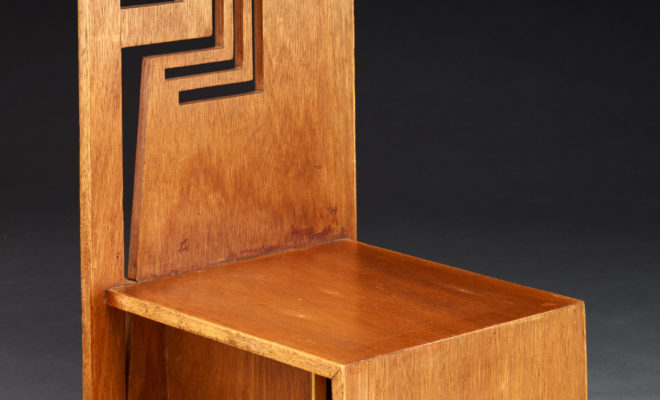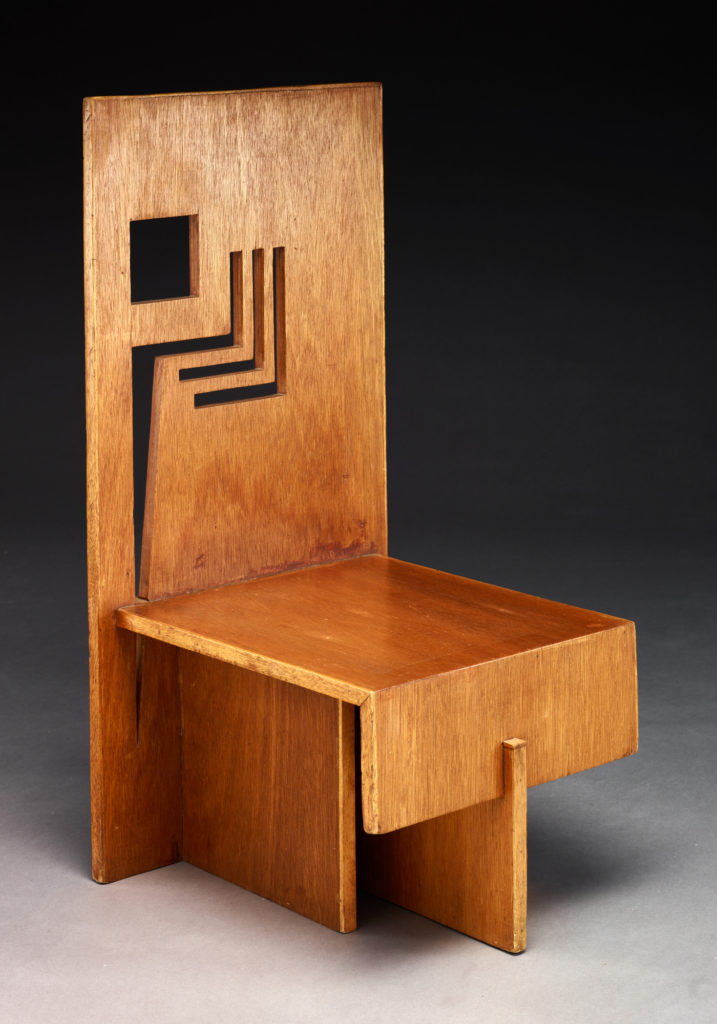 DALLAS MUSEUM OF ART, ANONYMOUS GIFT THROUGH THE 20TH-CENTURY DESIGN FUND
DALLAS MUSEUM OF ART, ANONYMOUS GIFT THROUGH THE 20TH-CENTURY DESIGN FUND
 DALLAS MUSEUM OF ART, ANONYMOUS GIFT THROUGH THE 20TH-CENTURY DESIGN FUND
DALLAS MUSEUM OF ART, ANONYMOUS GIFT THROUGH THE 20TH-CENTURY DESIGN FUND
By |
 DALLAS MUSEUM OF ART, ANONYMOUS GIFT THROUGH THE 20TH-CENTURY DESIGN FUND
DALLAS MUSEUM OF ART, ANONYMOUS GIFT THROUGH THE 20TH-CENTURY DESIGN FUND
THE USE OF INEXPENSIVE PLYWOOD as the primary design material evokes ideas of practicality, durability, and simplicity. In the hands of renowned architect Frank Lloyd Wright, the material becomes a signifier of innovation, modernity, and a new model for living. Designed in 1956 for the Paul J. Trier House in Des Moines, Iowa, this side chair follows the Usonian concept that Wright espoused in the 1940s and 1950s. As Wright explained: “Rugs, draperies, and furnishings that are suitable for a Usonian house are those . . . that are organic in character, that is, textures and patterns that sympathize in their own design and construction with the design and construction of the particular house they occupy and embellish.” Characteristic of many of the architect’s later commissions, bold geometry and modest materials, defined the Trier House.

Trier House Side Chair by Frank Lloyd Wright (1867–1959), plywood, c. 1956. DALLAS MUSEUM OF ART, ANONYMOUS GIFT THROUGH THE 20TH-CENTURY DESIGN FUND
The most intriguing elements of the side chair are the asymmetric structure and square and angular design motifs found both in the planar seat supports and the back. While emblematic of the geometry within the Trier House, similar motifs also appeared in the bases of chairs for the Paul R. Hanna House in Palo Alto, California (1937), and in the clerestory panels of other Usonian houses. Chairs very similar to this one were originally designed in 1953 for the Usonian House and Pavilion at the Solomon R. Guggenheim Museum’s Sixty Years of Living Architecture retrospective exhibition of Wright’s work.
Sarah Schleuning
Margot B. Perot Senior Curator of Decorative Arts and Design
Dallas Museum of Art
Texas

MODERN Magazine takes a fresh and intelligent approach as it examines buildings and interiors, furniture and objects, craft and art—delving into the creative process and offering sage advice for both the seasoned and novice collector or connoisseur.
© 2019 MODERN Magazine Media, LLC

Chad Jensen opened Method & Concept in Naples, Florida, in 2013 according to the Art Basel Miami Beach...

The annual Milan Design Week has long been the established benchmark of the industry. Comprised of the massive...

Those who don’t consider glass a major art medium will think again after visiting a fascinating exhibition that...

For Jane Withers, the London-based curator and writer who led Water Futures, design incubator A/D/O’s latest initiative, this...

Why an uncharacteristically meditative Memphis design mesmerized one resourceful bidder

TO STROLL ALONG STOCKHOLM’S HARBORS is to inhale the essentials of the city’s largesse and welcoming grandeur: the...